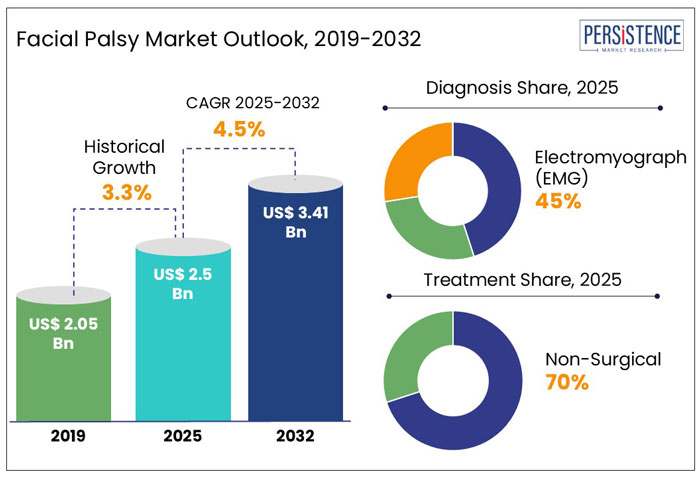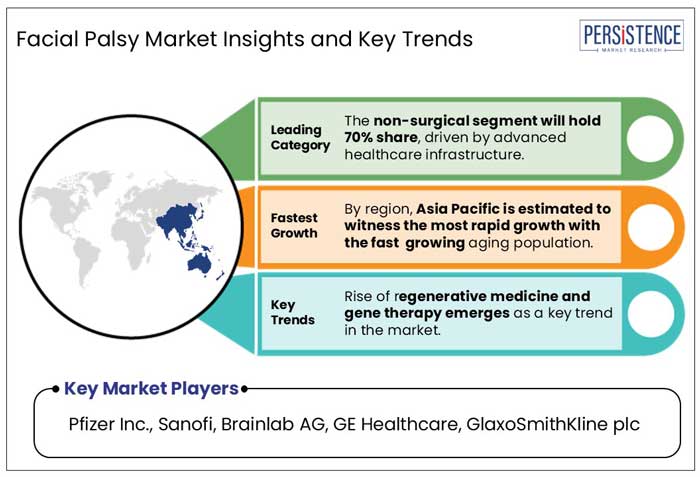Industry: Healthcare
Published Date: March-2025
Format: PPT*, PDF, EXCEL
Delivery Timelines: Contact Sales
Number of Pages: 250
Report ID: PMRREP35176
The global facial palsy market size is anticipated to rise from US$ 2.50 Bn in 2025 to US$ 3.41 Bn by 2032. It is projected to witness a CAGR of 4.5% from 2025 to 2032.
The market for facial palsy is evolving rapidly, driven by technological advancements, increasing patient awareness, and new treatment innovations. Game-changing innovations in diagnostics, regenerative medicine, and AI-driven rehabilitation are reshaping the industry.
AI-powered diagnostics are now being developed to analyse facial muscle movements, helping doctors detect early signs of nerve dysfunction.
As awareness increases and new treatments become more accessible, this market is poised for strong growth, offering hope to millions affected by facial paralysis.

Key Highlights of the Facial Palsy Market
|
Global Market Attributes |
Key Insights |
|
Facial Palsy Market Size (2025E) |
US$ 2.50 Bn |
|
Market Value Forecast (2032F) |
US$ 3.41 Bn |
|
Projected Growth (CAGR 2025 to 2032) |
4.5% |
|
Historical Market Growth (CAGR 2019 to 2024) |
3.3% |
Evolving Treatment Options Aided Market Growth Pre-2024
During the historical period from 2019 to 2024, the market has undergone significant changes over the years, shaped by medical advancements, rising awareness, and evolving treatment options.
The market was primarily driven by traditional therapies, including corticosteroids, physical therapy, and surgical interventions. However, accessibility remained a challenge, with high treatment costs and limited availability of specialized healthcare centers in many regions.
Breakthroughs in Regenerative Medicine to Augment Market Growth by 2032
During the forecast period from 2025 to 2032, the market is set for a transformation, fueled by breakthroughs in regenerative medicine, AI-driven diagnostics, and telemedicine.
Stem cell therapy, gene editing, and nerve regeneration techniques are expected to revolutionize treatment options, offering faster recovery times and long-term nerve repair.
AI-powered facial analysis tools will enhance early diagnosis, reducing misdiagnosis rates and improving patient outcomes. The rise of tele rehabilitation programs and virtual therapy apps will also make facial palsy treatment more accessible, especially in rural and underserved areas.
Advancements in Treatment Modalities is Transforming Facial Palsy Industry
One of the most significant growth drivers in the market is the rapid advancements in treatment modalities, which are continuously improving patient outcomes and expanding treatment options.
The industry's developments include medications, surgical interventions, nerve regeneration techniques, and rehabilitation therapies, offering hope for faster recovery and improved facial function. Developing targeted drug therapies aimed at protecting and repairing the facial nerve may further revolutionize treatment approaches.
With the integration of AI, robotics, and precision medicine, the future of facial palsy treatment looks increasingly patient-centered and technologically advanced. As research into regenerative medicine, robotics-assisted surgeries, and neuroplasticity-based therapies progresses, the market is expected to expand significantly.
High Treatment Costs and Limited Accessibility Hinders Market Growth Prospects
One of the biggest barriers in the market for facial palsy is the high cost of advanced therapies. Treatments such as facial reanimation surgeries, nerve grafts, and regenerative medicine therapies require specialized expertise and high-end technology.
With this the surgeries also requires multiple sessions, leading to expensive medical bills. Many patients, especially in low and middle-income countries, struggle to afford these treatments due to limited insurance coverage and high out-of-pocket expenses.
Access to specialized facial palsy treatment centers is often restricted to urban areas, making it difficult for rural patients to receive timely and high-quality care. Without affordable and widely accessible treatment options, market growth is slowed, limiting the reach of innovative medical advancements.
Rise of Regenerative Medicine and Gene Therapy Emerges as a Key Trend in the Market
One of the most exciting opportunities in the market for facial palsy is the advancement of regenerative medicine and gene therapy. Researchers are exploring stem cell therapy, neurotrophic factors, and gene-editing techniques to regenerate damaged facial nerves and restore lost muscle function.
Unlike traditional treatments that focus on symptom management, regenerative approaches aim to heal nerve injuries at the source, offering long-term functional recovery. Clinical trials on mesenchymal stem cells (MSCs) and CRISPR-based gene therapies are showing promising results, paving the way for groundbreaking, minimally invasive solutions.
As these innovations become commercially viable, they could revolutionize facial palsy treatment and attract significant investment from biotechnology and pharmaceutical companies.
Electromyography (EMG) Dominates the Diagnosis Segment of the Market with a 45% Share with its Detailing in Diagnosis
EMG plays a pivotal role in assessing the electrical activity of facial muscles, providing critical insights into nerve functionality and the extent of muscle involvement. EMG provides detailed information about the location and severity of nerve damage, which is crucial for tailoring appropriate treatment plans. ?
It can detect abnormalities even when clinical symptoms are minimal, allowing for prompt intervention and potentially better outcomes.? The results from an EMG can inform physical therapists about specific muscles that require targeted rehabilitation, enhancing the effectiveness of therapy.
As the market continues to evolve, EMG's central role is likely to persist, driven by ongoing advancements in diagnostic technologies and a deeper understanding of neuromuscular disorders.
Non-Surgical Treatments with its Safety Dominates the Market Share with 70% Revenue Share
Non-surgical treatments, with a significant emphasis on corticosteroid medications, have established themselves as the leading segment in the market. The effectiveness of non-surgical treatments, coupled with accessibility and a favorable safety profile, makes them the preferred choice for both patients and healthcare providers.
Non-surgical treatments typically involve fewer risks and complications than surgical procedures, making them a safer initial treatment option for many patients. Apart from being safe, non-surgical treatments like corticosteroids are readily available and can be administered in various healthcare settings, making them accessible to a broad patient population.
As the understanding of facial nerve disorders advances, these non-surgical interventions are likely to maintain their prominence, offering effective solutions for individuals affected by facial palsy.

North America's dominance in the global market is underpinned by its advanced healthcare infrastructure, ongoing technological advancements, and a demographic trend toward an aging population seeking aesthetic and reconstructive treatments.
The United States, contributes to almost 40% of total sales in the region, experiencing a growth rate of 2.5% in the first three quarters of 2024. The growth of the US market is further attributed to the increasing demand for aesthetic treatments among the aging population and individuals seeking facial rejuvenation following weight loss.
The market for facial palsy in Europe is anticipated to grow at a steady rate over the forecast period with the market revenue to reach a valuation of around US$ 1.5 billion by 2032. ?Germany stands out with the highest anticipated growth rate in the region, reflecting the country's commitment to medical excellence and innovation.
Europe's rich cultural heritage, combined with a growing acceptance of aesthetic procedures, has led to a unique market landscape where tradition meets modernity. The region's well-established regulatory framework ensures the safety and efficacy of facial implants, fostering trust among consumers.
Asia Pacific is experiencing significant growth in the market, driven by factors such as increasing disposable incomes, a growing aging population, and a rising interest in cosmetic procedures.
As societal acceptance of aesthetic procedures continues to rise, the region offers significant opportunities for industry stakeholders. Countries like China and India are witnessing a significant increase in their elderly populations.
Further, technological advancements also play a major role in the market's growth. The introduction of minimally invasive procedures and advanced injectable products has attracted individuals seeking effective yet less invasive aesthetic solutions, eventually catering to the region's market share.
The market is experiencing notable growth over the forecast period. The market expansion is driven by factors such as the rising prevalence of facial nerve disorders, advancements in treatment technologies, and a growing awareness of facial aesthetics.
Key players in this market are focusing on innovative solutions, such as neuromuscular blockade monitors, to enhance patient rehabilitation and therapy. Geographically, North America leads the market due to advanced healthcare infrastructure and significant R&D investments, while the Asia Pacific region is anticipated to witness rapid growth owing to increasing healthcare expenditure and awareness.
|
Report Attributes |
Details |
|
Historical Data/Actuals |
2019 - 2024 |
|
Forecast Period |
2025 - 2032 |
|
Market Analysis Units |
Value: US$ Bn/Mn, Volume: As applicable |
|
Geographical Coverage |
|
|
Segmental Coverage |
|
|
Competitive Analysis |
|
|
Report Highlights |
|
|
Customization and Pricing |
Available upon request |
By Diagnosis
By Treatment
By End Use
By Region
To know more about delivery timeline for this report Contact Sales

The market is set to reach US$ 2.50 Bn in 2025.
Pfizer Inc., Sanofi, Brainlab AG, are a few leading players.
The industry is estimated to rise at a CAGR of 4.5% through 2032.
The market is anticipated to reach a valuation of US$ 3.41 billion by 2032.
North America dominates the global market share for facial palsy in 2025.